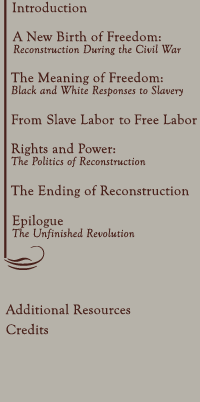








Introduction
The most difficult task confronting many Southerners during Reconstruction was devising a new system of labor to replace the shattered world of slavery. The economic lives of planters, former slaves, and nonslaveholding whites, were transformed after the Civil War.
Planters found it hard to adjust to the end of slavery. Accustomed to absolute control over their labor force, many sought to restore the old discipline, only to meet determined opposition from the freedpeople, who equated freedom with economic autonomy.
Many former slaves believed that their years of unrequited labor gave them a claim to land; "forty acres and a mule" became their rallying cry. White reluctance to sell to blacks, and the federal government's decision not to redistribute land in the South, meant that only a small percentage of the freedpeople became landowners. Most rented land or worked for wages on white-owned plantations.
During Reconstruction, many small white farmers, thrown into poverty by the war, entered into cotton production, a major change from prewar days when they concentrated on growing food for their own families.
Out of the conflicts on the plantations, new systems of labor slowly emerged to take the place of slavery. Sharecropping dominated the cotton and tobacco South, while wage labor was the rule on sugar plantations.
Increasingly, both white and black farmers came to depend on local merchants for credit. A cycle of debt often ensued, and year by year the promise of economic independence faded.
Copyright
2003